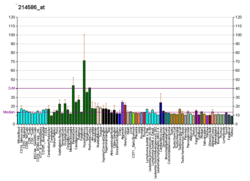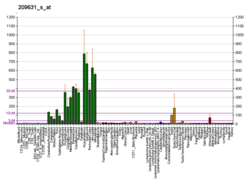GPR37: Difference between revisions
Appearance
Content deleted Content added
Citation bot (talk | contribs) m Add: hdl, url. Removed URL that duplicated unique identifier. | You can use this bot yourself. Report bugs here.| Activated by User:Marianne Zimmerman |
m Added a small addition |
||
| Line 6: | Line 6: | ||
GPR37 has been shown to [[Protein-protein interaction|interact]] with [[HSPA1A]]<ref name=pmid12150907>{{cite journal | vauthors = Imai Y, Soda M, Hatakeyama S, Akagi T, Hashikawa T, Nakayama KI, Takahashi R | title = CHIP is associated with Parkin, a gene responsible for familial Parkinson's disease, and enhances its ubiquitin ligase activity | journal = Mol. Cell | volume = 10 | issue = 1 | pages = 55–67 | date = July 2002 | pmid = 12150907 | doi = 10.1016/S1097-2765(02)00583-X }}</ref> and [[Parkin (ligase)]].<ref name=pmid12150907/><ref name=pmid11439185>{{cite journal | vauthors = Imai Y, Soda M, Inoue H, Hattori N, Mizuno Y, Takahashi R | title = An unfolded putative transmembrane polypeptide, which can lead to endoplasmic reticulum stress, is a substrate of Parkin | journal = Cell | volume = 105 | issue = 7 | pages = 891–902 | date = June 2001 | pmid = 11439185 | doi = 10.1016/S0092-8674(01)00407-X }}</ref> |
GPR37 has been shown to [[Protein-protein interaction|interact]] with [[HSPA1A]]<ref name=pmid12150907>{{cite journal | vauthors = Imai Y, Soda M, Hatakeyama S, Akagi T, Hashikawa T, Nakayama KI, Takahashi R | title = CHIP is associated with Parkin, a gene responsible for familial Parkinson's disease, and enhances its ubiquitin ligase activity | journal = Mol. Cell | volume = 10 | issue = 1 | pages = 55–67 | date = July 2002 | pmid = 12150907 | doi = 10.1016/S1097-2765(02)00583-X }}</ref> and [[Parkin (ligase)]].<ref name=pmid12150907/><ref name=pmid11439185>{{cite journal | vauthors = Imai Y, Soda M, Inoue H, Hattori N, Mizuno Y, Takahashi R | title = An unfolded putative transmembrane polypeptide, which can lead to endoplasmic reticulum stress, is a substrate of Parkin | journal = Cell | volume = 105 | issue = 7 | pages = 891–902 | date = June 2001 | pmid = 11439185 | doi = 10.1016/S0092-8674(01)00407-X }}</ref> |
||
GPR37 is a receptor for [[prosaposin]]. It was previously thought to be a receptor for [[head activator]], a [[neuropeptide]] found in the [[hydra (genus)|hydra]], but early reports of head activator in mammals were never confirmed.<ref>{{cite journal |first1=Rebecca C.|last1=Meyer |first2=Michelle M.|last2=Giddens |first3=Stacy A.|last3=Schaefer |first4=Randy A.|last4=Hall |title=GPR37 and GPR37L1 are receptors for the neuroprotective and glioprotective factors prosaptide and prosaposin |date=4 June 2013 |journal=Proceedings of the National Academy of Sciences |volume=110 |issue=23 |pages=9529–34 |doi=10.1073/pnas.1219004110 |pmid=23690594 |pmc=3677493}} |
GPR37 is a receptor for [[prosaposin]]. It was previously thought to be a receptor for [[head activator]], a [[neuropeptide]] found in the [[hydra (genus)|hydra]], but early reports of head activator in mammals were never confirmed.<ref>{{cite journal |first1=Rebecca C.|last1=Meyer |first2=Michelle M.|last2=Giddens |first3=Stacy A.|last3=Schaefer |first4=Randy A.|last4=Hall |title=GPR37 and GPR37L1 are receptors for the neuroprotective and glioprotective factors prosaptide and prosaposin |date=4 June 2013 |journal=Proceedings of the National Academy of Sciences |volume=110 |issue=23 |pages=9529–34 |doi=10.1073/pnas.1219004110 |pmid=23690594 |pmc=3677493}} |
||
</ref> |
|||
GPR37 signaling has been shown to modulates the migration of [[Olfactory Ensheathing Cells]] (OECs) and [[Gonadotropin-Releasing Hormone]] (GnRH) Cells in Mice.<ref>{{cite journal |first1=Hassan.|last1=Saadi|first2=Yufei|last2=Shan|first3=Susan|last3=Wray|title=GPR37 Signaling Modulates Migration of Olfactory Ensheathing Cells and Gonadotropin Releasing Hormone Cells in Mice |date=9 May 2019 |journal=Front Cell Neurosci. |doi=10.3389/fncel.2019.00200 |pmid=31143101 |pmc=PMC6521704}} |
|||
</ref> |
</ref> |
||
| Line 21: | Line 24: | ||
* {{cite journal | vauthors = Kubota K, Niinuma Y, Kaneko M, Okuma Y, Sugai M, Omura T, Uesugi M, Uehara T, Hosoi T, Nomura Y | title = Suppressive effects of 4-phenylbutyrate on the aggregation of Pael receptors and endoplasmic reticulum stress | journal = J. Neurochem. | volume = 97 | issue = 5 | pages = 1259–68 | year = 2006 | pmid = 16539653 | doi = 10.1111/j.1471-4159.2006.03782.x }} |
* {{cite journal | vauthors = Kubota K, Niinuma Y, Kaneko M, Okuma Y, Sugai M, Omura T, Uesugi M, Uehara T, Hosoi T, Nomura Y | title = Suppressive effects of 4-phenylbutyrate on the aggregation of Pael receptors and endoplasmic reticulum stress | journal = J. Neurochem. | volume = 97 | issue = 5 | pages = 1259–68 | year = 2006 | pmid = 16539653 | doi = 10.1111/j.1471-4159.2006.03782.x }} |
||
* {{cite journal | vauthors = Omura T, Kaneko M, Okuma Y, Orba Y, Nagashima K, Takahashi R, Fujitani N, Matsumura S, Hata A, Kubota K, Murahashi K, Uehara T, Nomura Y | title = A ubiquitin ligase HRD1 promotes the degradation of Pael receptor, a substrate of Parkin | journal = J. Neurochem. | volume = 99 | issue = 6 | pages = 1456–69 | year = 2006 | pmid = 17059562 | doi = 10.1111/j.1471-4159.2006.04155.x | url = http://eprints.lib.hokudai.ac.jp/dspace/bitstream/2115/17141/1/JN99-6-2006.pdf | hdl = 2115/17141 }} |
* {{cite journal | vauthors = Omura T, Kaneko M, Okuma Y, Orba Y, Nagashima K, Takahashi R, Fujitani N, Matsumura S, Hata A, Kubota K, Murahashi K, Uehara T, Nomura Y | title = A ubiquitin ligase HRD1 promotes the degradation of Pael receptor, a substrate of Parkin | journal = J. Neurochem. | volume = 99 | issue = 6 | pages = 1456–69 | year = 2006 | pmid = 17059562 | doi = 10.1111/j.1471-4159.2006.04155.x | url = http://eprints.lib.hokudai.ac.jp/dspace/bitstream/2115/17141/1/JN99-6-2006.pdf | hdl = 2115/17141 }} |
||
* {{cite journal | vauthors = Saadi H, Shan Y, Wray S | title = GPR37 Signaling Modulates Migration of Olfactory Ensheathing Cells and Gonadotropin Releasing Hormone Cells in Mice | journal = Front Cell Neurosci. | pmid = 31143101 | doi = 10.3389/fncel.2019.00200 }} |
|||
{{refend}} |
{{refend}} |
||
Revision as of 19:12, 28 October 2019
| GPR37 | |||||||||||||||||||||||||||||||||||||||||||||||||||
|---|---|---|---|---|---|---|---|---|---|---|---|---|---|---|---|---|---|---|---|---|---|---|---|---|---|---|---|---|---|---|---|---|---|---|---|---|---|---|---|---|---|---|---|---|---|---|---|---|---|---|---|
| Identifiers | |||||||||||||||||||||||||||||||||||||||||||||||||||
| Aliases | GPR37, EDNRBL, PAELR, hET(B)R-LP, G protein-coupled receptor 37 | ||||||||||||||||||||||||||||||||||||||||||||||||||
| External IDs | OMIM: 602583; MGI: 1313297; HomoloGene: 3875; GeneCards: GPR37; OMA:GPR37 - orthologs | ||||||||||||||||||||||||||||||||||||||||||||||||||
| |||||||||||||||||||||||||||||||||||||||||||||||||||
| |||||||||||||||||||||||||||||||||||||||||||||||||||
| |||||||||||||||||||||||||||||||||||||||||||||||||||
| |||||||||||||||||||||||||||||||||||||||||||||||||||
| Wikidata | |||||||||||||||||||||||||||||||||||||||||||||||||||
| |||||||||||||||||||||||||||||||||||||||||||||||||||
Probable G-protein coupled receptor 37 is a protein that in humans is encoded by the GPR37 gene.[5][6]
Interactions
GPR37 has been shown to interact with HSPA1A[7] and Parkin (ligase).[7][8] GPR37 is a receptor for prosaposin. It was previously thought to be a receptor for head activator, a neuropeptide found in the hydra, but early reports of head activator in mammals were never confirmed.[9]
GPR37 signaling has been shown to modulates the migration of Olfactory Ensheathing Cells (OECs) and Gonadotropin-Releasing Hormone (GnRH) Cells in Mice.[10]
References
- ^ a b c GRCh38: Ensembl release 89: ENSG00000170775 – Ensembl, May 2017
- ^ a b c GRCm38: Ensembl release 89: ENSMUSG00000039904 – Ensembl, May 2017
- ^ "Human PubMed Reference:". National Center for Biotechnology Information, U.S. National Library of Medicine.
- ^ "Mouse PubMed Reference:". National Center for Biotechnology Information, U.S. National Library of Medicine.
- ^ Marazziti D, Golini E, Gallo A, Lombardi MS, Matteoni R, Tocchini-Valentini GP (November 1997). "Cloning of GPR37, a gene located on chromosome 7 encoding a putative G-protein-coupled peptide receptor, from a human frontal brain EST library". Genomics. 45 (1): 68–77. doi:10.1006/geno.1997.4900. PMID 9339362.
- ^ "Entrez Gene: GPR37 G protein-coupled receptor 37 (endothelin receptor type B-like)".
- ^ a b Imai Y, Soda M, Hatakeyama S, Akagi T, Hashikawa T, Nakayama KI, Takahashi R (July 2002). "CHIP is associated with Parkin, a gene responsible for familial Parkinson's disease, and enhances its ubiquitin ligase activity". Mol. Cell. 10 (1): 55–67. doi:10.1016/S1097-2765(02)00583-X. PMID 12150907.
- ^ Imai Y, Soda M, Inoue H, Hattori N, Mizuno Y, Takahashi R (June 2001). "An unfolded putative transmembrane polypeptide, which can lead to endoplasmic reticulum stress, is a substrate of Parkin". Cell. 105 (7): 891–902. doi:10.1016/S0092-8674(01)00407-X. PMID 11439185.
- ^ Meyer, Rebecca C.; Giddens, Michelle M.; Schaefer, Stacy A.; Hall, Randy A. (4 June 2013). "GPR37 and GPR37L1 are receptors for the neuroprotective and glioprotective factors prosaptide and prosaposin". Proceedings of the National Academy of Sciences. 110 (23): 9529–34. doi:10.1073/pnas.1219004110. PMC 3677493. PMID 23690594.
- ^ Saadi, Hassan.; Shan, Yufei; Wray, Susan (9 May 2019). "GPR37 Signaling Modulates Migration of Olfactory Ensheathing Cells and Gonadotropin Releasing Hormone Cells in Mice". Front Cell Neurosci. doi:10.3389/fncel.2019.00200. PMC 6521704. PMID 31143101.
{{cite journal}}: CS1 maint: PMC format (link) CS1 maint: unflagged free DOI (link)
Further reading
- Zeng Z, Su K, Kyaw H, Li Y (1997). "A novel endothelin receptor type-B-like gene enriched in the brain". Biochem. Biophys. Res. Commun. 233 (2): 559–67. doi:10.1006/bbrc.1997.6408. PMID 9144577.
- Donohue PJ, Shapira H, Mantey SA, Hampton LL, Jensen RT, Battey JF (1998). "A human gene encodes a putative G protein-coupled receptor highly expressed in the central nervous system". Brain Res. Mol. Brain Res. 54 (1): 152–60. doi:10.1016/S0169-328X(97)00336-7. PMID 9526070.
- Imai Y, Soda M, Inoue H, Hattori N, Mizuno Y, Takahashi R (2001). "An unfolded putative transmembrane polypeptide, which can lead to endoplasmic reticulum stress, is a substrate of Parkin". Cell. 105 (7): 891–902. doi:10.1016/S0092-8674(01)00407-X. PMID 11439185.
- Imai Y, Soda M, Hatakeyama S, Akagi T, Hashikawa T, Nakayama KI, Takahashi R (2002). "CHIP is associated with Parkin, a gene responsible for familial Parkinson's disease, and enhances its ubiquitin ligase activity". Mol. Cell. 10 (1): 55–67. doi:10.1016/S1097-2765(02)00583-X. PMID 12150907.
- Yang Y, Nishimura I, Imai Y, Takahashi R, Lu B (2003). "Parkin suppresses dopaminergic neuron-selective neurotoxicity induced by Pael-R in Drosophila". Neuron. 37 (6): 911–24. doi:10.1016/S0896-6273(03)00143-0. PMID 12670421.
- Imai Y, Soda M, Murakami T, Shoji M, Abe K, Takahashi R (2003). "A product of the human gene adjacent to parkin is a component of Lewy bodies and suppresses Pael receptor-induced cell death". J. Biol. Chem. 278 (51): 51901–10. doi:10.1074/jbc.M309655200. PMID 14532270.
{{cite journal}}: CS1 maint: unflagged free DOI (link) - Kubota K, Niinuma Y, Kaneko M, Okuma Y, Sugai M, Omura T, Uesugi M, Uehara T, Hosoi T, Nomura Y (2006). "Suppressive effects of 4-phenylbutyrate on the aggregation of Pael receptors and endoplasmic reticulum stress". J. Neurochem. 97 (5): 1259–68. doi:10.1111/j.1471-4159.2006.03782.x. PMID 16539653.
- Omura T, Kaneko M, Okuma Y, Orba Y, Nagashima K, Takahashi R, Fujitani N, Matsumura S, Hata A, Kubota K, Murahashi K, Uehara T, Nomura Y (2006). "A ubiquitin ligase HRD1 promotes the degradation of Pael receptor, a substrate of Parkin" (PDF). J. Neurochem. 99 (6): 1456–69. doi:10.1111/j.1471-4159.2006.04155.x. hdl:2115/17141. PMID 17059562.
- Saadi H, Shan Y, Wray S. "GPR37 Signaling Modulates Migration of Olfactory Ensheathing Cells and Gonadotropin Releasing Hormone Cells in Mice". Front Cell Neurosci. doi:10.3389/fncel.2019.00200. PMID 31143101.
{{cite journal}}: CS1 maint: unflagged free DOI (link)






